Source: https://www.youtube.com/watch?v=wqbZlAEUb5w&ab_channel=Netflix
By: Beata Garrett | @zhongxia246
Haunted houses are a staple in horror, and have a rich history of terrifying us as places that blur the boundaries between the living and the dead, hell and heaven, and reality and delusion.
What I love about haunted houses are the ways in which they prey emotionally and psychically on their inhabitants, and the parasitic relationships that emerge in stories like Shirley Jackson’s The Haunting of Hill House and Andy Mitton’s The Witch in the Window.
One of the frightening things about haunted houses is the subversion of a safe space and the violation that comes from its haunting. When it turns on us, we feel betrayed and it becomes a fight for our lives.
With that being said, I had no idea that I would enjoy Netflix’s The House as much as I did. The House is a stop-motion anthology film that focuses on the lives of three different inhabitants who live in the same house in various eras. While the inhabitants transcend time and species, they have the same problem with the house–it’s feeding off them and won’t be satisfied until they’re completely destroyed.
[Editor’s Note: Please assume from this point forward that everything–quotes, images, and summaries–in this post, unless cited otherwise, comes directly from Netflix’s The House (2022). Thank you.]
Part 1.
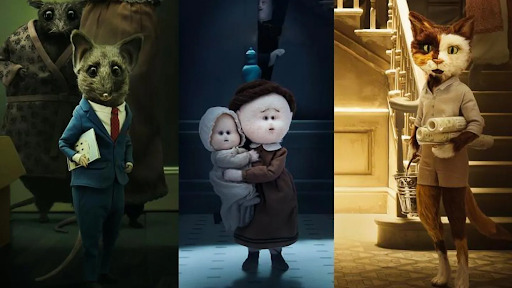
In Part One, a family moves into an eccentric architect’s house to escape poverty and find themselves slowly turned into furniture. The children, Mabel and Isobel (seen above in the middle), are bewildered by their parents’ transformation and eventually escape as their parents burn alive.
The house reminded me of the Winchester Mystery House with its labyrinthine structure, and the construction workers add a menacing tone with their blank stares and saws as they destroy and rebuild it.
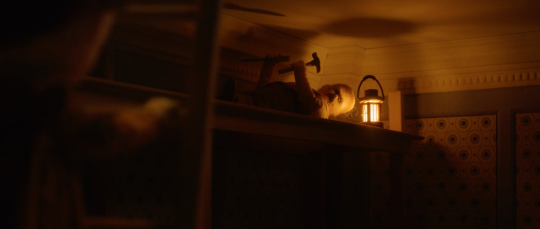
I would instantly bust out the holy water
In return for luxury, the family gives up the warmth of their previous home. The father dreams of a big fireplace and proving his success to more affluent relatives, but achieves it at the cost of his family.
When they move into the new house, there is indeed a fireplace, but it mysteriously requires him to burn the furniture of their previous home to start a fire. He burns any remnant of their previous lives until he’s left with Mabel’s dollhouse–this is the final straw, and the family structure completely collapses after he tosses it into the fire, dooming him and his wife to complete their transformation into furniture.
Similarly, the mother becomes obsessed with making curtains and becomes indistinguishable from them. She spends all day sewing and can’t find the time to play with her children or even eat.
The house’s consumption of the parents is an eerie depiction of the struggles of working class people and of the lengths to which humans will go to achieve social mobility. In the end, they can’t even enjoy the luxuries they’ve worked so hard for and their children become lost in the house, unable to connect to their parents.
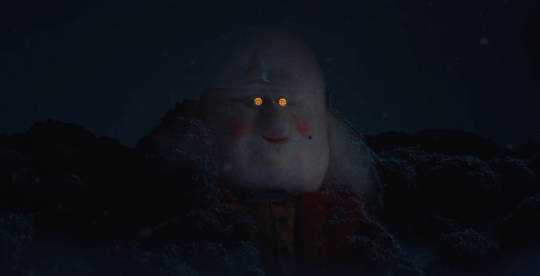
There’s a fantastic shot of the architect’s face overlapping with the house that shows the power he has over them. He orders the construction workers to remove stairs and block hallways with no rhyme or reason, and appears to be laughing in this moment, as though he enjoys the pain of the family.
Like Mabel’s dolls, the architect moves the family as he pleases through the changing construction until he gets bored and lets it all burn.
Part 2.
Part Two is set in more modern times and follows an anthropomorphic rat who’s developing the house to sell. It’s a bizarre story with morbid humor and is my favorite part. If you’re going to watch any story in the anthology, I highly recommend this one.
At first, it seems like the developer has everything under control. He has a bluetooth, talks to people at banks and seems to have a line of buyers ready. All he needs to do is successfully transform most of the house into a stock broker’s wet dream.
There’s a dark undercurrent early on though as we see him sleeping in the basement and unable to fully exterminate the bugs in the house.

The developer is painfully alone and has put everything he has into the house. If you’ve seen Bong Joon-ho’s Parasite, you’ll be reminded of the class divide and desperation of those who live in the basement and those who live on the upper floors.
He eats protein bars so he can save money to spend on hor d’oeuvres for potential buyers, and seems to be in a distant relationship with a lover whom he fights with over the phone. Like the family in Part One, the house is already taking a toll on him and it won’t be long before it completely ruins this man.
As the date for the house viewing draws closer, the developer becomes more anxious to get rid of the bugs. He identifies them as fur beetles, which are known to eat all kinds of fabric. By this point, his slick and suave facade has been stripped from him. He’s trying to exterminate them in his underwear. Unfortunately, the repellant also hurts him and he’s knocked unconscious at several points from using too much.
It’s incredible how disgusting the bugs are and the image of him being surrounded by them will haunt me a bit–especially since I have a fear of bed bugs from getting them once. They’re a reminder that humans might be on top of the food chain for now, but bugs will outlive us after we disappear.
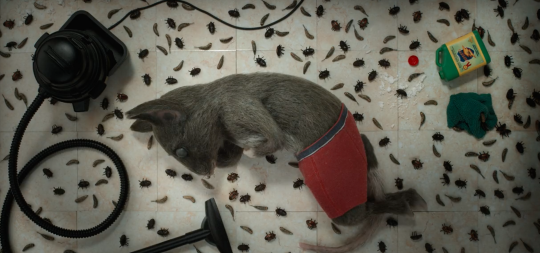
When the prospective buyers arrive, they immediately disappoint the developer. None of them seem interested in actually buying the house and they leave dirt on the immaculate carpets. Soon, it’s completely destroyed.
A strange couple comes in, driving the others out, and they make themselves at home. They eat his food and keep telling him, “We’re very interested in the house” without ever taking the next step in the process.
There are two shots in the story which perfectly demonstrate the developer’s control then loss of it, helpfully highlighted by the portrait hanging over the bed:

As the couple intrudes further, the developer’s patience runs out.
There’s an incredible sequence of the bugs dancing–almost mocking him for his inability to turn these intruders away. He calls the police, who come but give him a warning instead to stop bothering his “lover.” The lover turns out to be his dentist, and he admits that he did harass him. However, the developer dismisses the severity of his harassment and tries to get the police to arrest the couple instead.
This parallels the intrusion of the couple and the reveal works as a great criticism of the ways in which people intrude into other people’s space emotionally–the parasite isn’t just the couple, but the developer too.
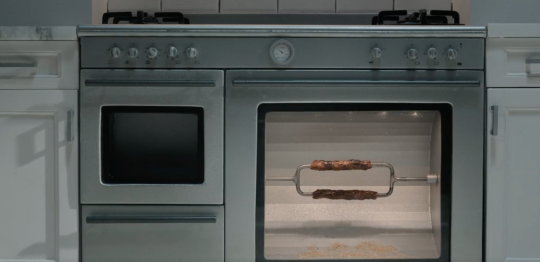
An important symbol linking all three stories is the fireplace, which serves as a stand-in for the characters’ desires to refurbish the house–something they believe will change their lives for the better.
In Part Two, it’s been reconstructed into a rotisserie oven, which the developer tries to show off. The end product comes out looking more like feces, which is an appropriate depiction of his dreams, and is completely destroyed by the end.
The final scene is of the couple revealing their true nature as the bugs that the developer tried to exterminate, and whom he lives comfortably among now. His bluetooth and all the other trappings of modern-humanity–visualized through technology and comforts–are gone and he seems at peace. This horrific scene implies that the destruction of the house was inevitable and that no amount of wallpaper can change that. The house always changes its inhabitants, not the other way around.
It also criticizes the developers who buy houses to sell at exorbitant prices without caring about the inhabitants already living in it, the prospective buyers who turn out to be as destructive as the bugs anyway, and the entire real estate system that allows this to happen. In the end, neither the buyers or the developer are better than the bugs, and the story offers a mirror to the real-life (and often brutal) housing market in our world.
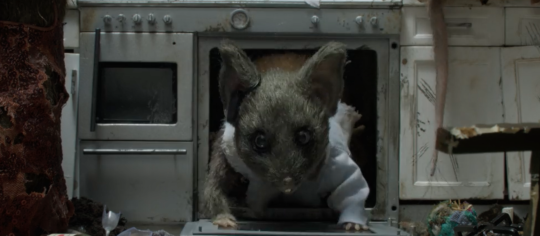
It might be disgusting for the humans watching it, but rats and bugs are also natural creatures in our environment and they make their homes in the same houses we live in. As civilized as we like to think we are, vermin will be found in even the wealthiest of homes.
Part 3.
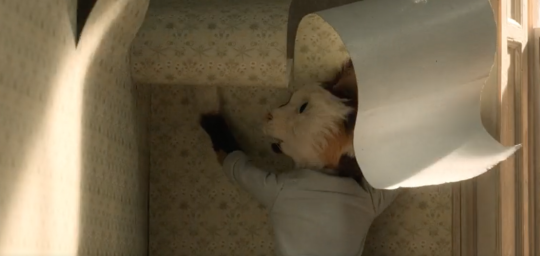
Part Three didn’t really speak to me personally, but I admire its attempt to portray a woman who must deal with her own grief to break free from the house. It’s an optimistic bookend to the other stories, and demonstrates what someone would need to escape.
Rosa is an anthropomorphic cat who’s trying to fix the house, but encounters many difficulties as it continues falling apart. On top of that, her tenants pay their rent in fish and gemstones. Unfortunately, her role as a developer is too similar to the previous story’s protagonist. Though, I admit that her reason for being invested in the house would’ve been more impactful on me as a viewer if it had been more thoroughly fleshed out.
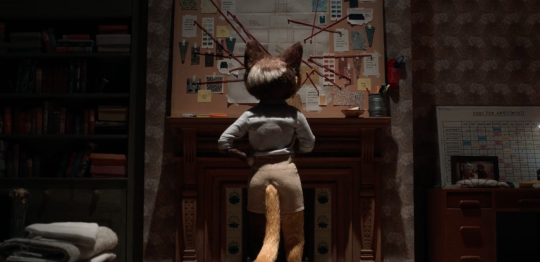
It’s shown that she has no hobbies and life outside of the house–this is contrasted by her tenants who find fulfillment in their art and spiritual healing. Rosa’s version of the fireplace is mapped out with her restoration plan and just when she thinks she’s found someone to help, he destroys part of the house to build a boat.
When her tenants decide to leave on the boats they’ve built, Rosa breaks down and begs for them to stay. She realizes she doesn’t want to be alone but doesn’t know how to leave the house that she’s dedicated most of her life to. Rosa tells one of them, “You’ll never find a house like this again,” and they simply reply, “There’ll be something else.” It’s implied from a picture that her family lived in the house or were trying to fix it at least, and she sees them leaving as her failing them.
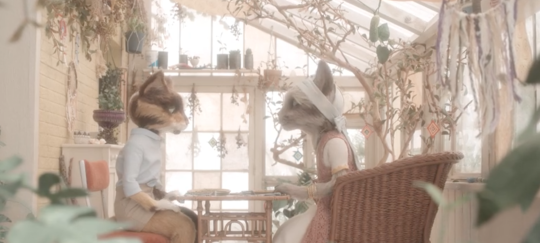
Unlike the previous stories, Rosa is able to find her freedom and escape the parasitic influence of the house by destroying it to make her own boat. She sails away with her tenants, still held up by the house but no longer letting it control her.
It’s a beautiful moment of release and joy, and a great message in being able to let go of harmful things without forgetting your loved ones to seek a better future.
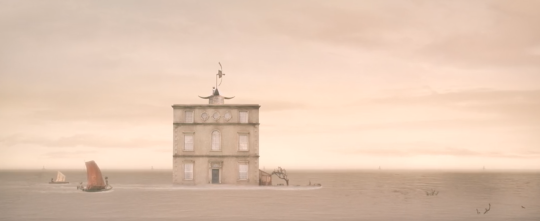
In conclusion, The House is a gorgeous anthology that fully utilizes the power of stop-motion animation. The stories are a great mix of horror and comedy, with each team of directors bringing something unique to their part. I will never be tired of haunted houses and stories that explore the parasitic relationships humans develop to objects, especially if they’re done as well as this.
If you have time, definitely sit down and watch this newly released movie.
Copyedited by: Krow Smith| @coffeewithkrow
